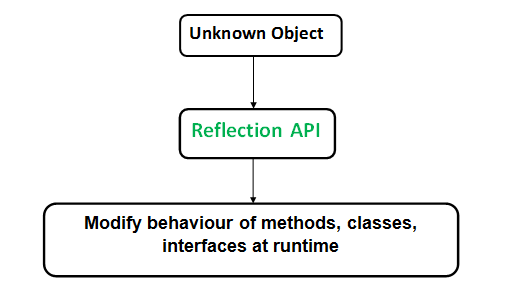

- #Java reflection get return from method with argument how to
- #Java reflection get return from method with argument code
Extensions to the language core were not necessary. With the Reflection API of JDK 1.1, a library interface was created that implements all of the abilities mentioned (and a few more) and makes it available to any application as an integral part of the Java class library. So a mechanism was sought that made these runtime system capabilities, which are normally requested by the compiler, available to "normal" applications. Furthermore, static or instance-based methods should be called and member variables should be accessible even if their name is only known when the program is running. Rather, what was needed was the ability to load and instantiate classes (also with parameterized constructors) without their name having to be known at compile time. In particular, the development of the bean and serialization APIs was not possible with the language properties available in version 1.0. While this is not a problem for most common applications, it is inadequate for developing generic tools and highly configurable applications that are extensible with plug-ins.
#Java reflection get return from method with argument code
In order to create an object, to call one of its methods or to access one of its member variables, the code of the class had to be known at compile time. This example will print out the text " developing JDK 1.1, the developers were confronted with a weakness in Java that made it impossible to develop certain types of tools and libraries: the static structure of classes and objects. Here is an example of accessing the component type array:Ĭlass stringArra圜lass = strings.getClass() Ĭlass stringArra圜omponentType = stringArra圜lass.getComponentType() The component type of a String array is the Class object. For instance, the component type of an int array is the int.class Class object. The component type is the type of the items in Once you have obtained the Class object for an array you can access its component type ("is array: " + stringArra圜lass.isArray()) To make sure that the Class object really is an array, you can call theĬlass stringArra圜lass = Array.newInstance(String.class, 0).getClass() This presents a single, uniform method to access the array class of arrays of any type. Here is how that looks:Ĭlass stringArra圜lass = Array.newInstance(theClass, 0).getClass() Obtain the class object from that empty array. The solution, or workaround as you might call it, is to create an empty array of the desired type and Once you have obtained the Class object of a type there is a simple way to obtain If("long".equals(className)) return long.class I usually do something like this to obtain the class name for primitives as well as objects: This means an array of objects with the given type.Īs a side note, you cannot obtain the class object of primitives using Class.forName().īoth of the examples below result in a ClassNotFoundException: Notice the [L to the left of the class name, and the This works for all otherįor objects you need to use a slightly different notation:Ĭlass stringArra圜lass = Class.forName("[ ") It is the class of an int array I am interested in. The JVM represents an int via the letter I. Primitive int array class object like this: Using non-reflection code you can do like this:ĭoing this using Class.forName() is not quite straightforward.
#Java reflection get return from method with argument how to
One of the problems I ran into when implementing the script language inīutterfly DI Container was how to obtain the Class objectįor arrays via Java Reflection. ("intArray = " + Array.get(intArray, 2)) ("intArray = " + Array.get(intArray, 1))

("intArray = " + Array.get(intArray, 0))

It is also possible to access the elements of an array using Java Reflection. The second parameter states how many elements the array should have space for. To the Array.newInstance() method tells what type each element in the array shouldīe of. This code sample creates an array of int. Int intArray = (int) Array.newInstance(int.class, 3) Here is an example showing how to create an array: Suite, which contains utility methods for sorting arrays, converting them to collections etc.Ĭreating arrays via Java Reflection is done using the class. Working with arrays via Java Reflection is done using the class.ĭo not confuse this class with the class in the Java Collections The current edition takes his comments into Which commented on the first edition of this text. Note: This text has been updated after reading Eyal Lupu's blog post "Two Side Notes About Arrays and Reflection" Text will discuss how to both create arrays and get their class objects via Java Reflection. Obtain the Class object for a certain type of array, like int etc. Working with arrays in Java Reflection can be a bit tricky at times.


 0 kommentar(er)
0 kommentar(er)
